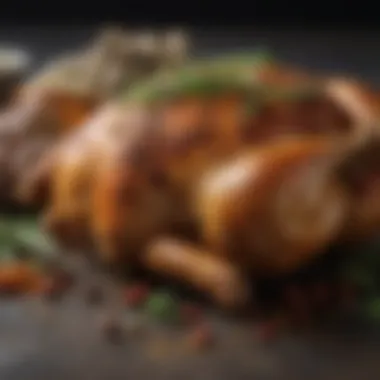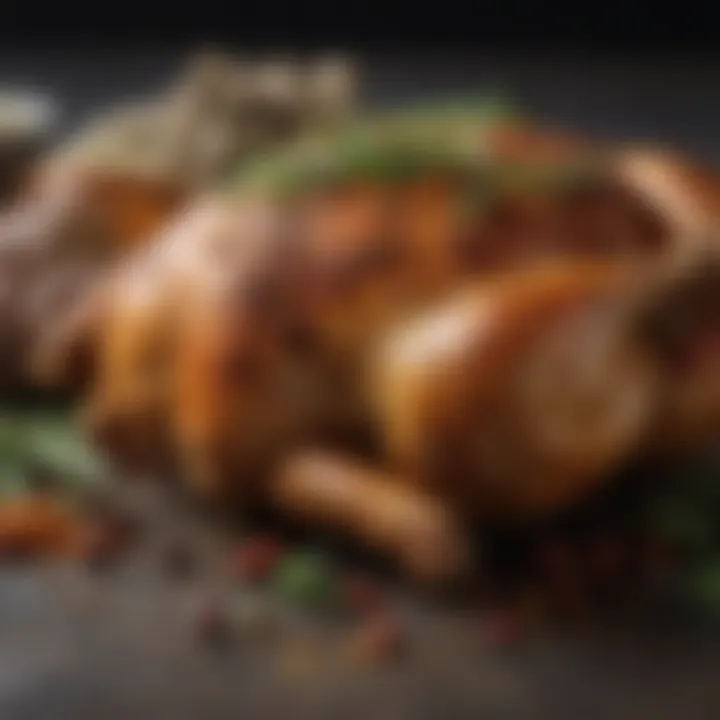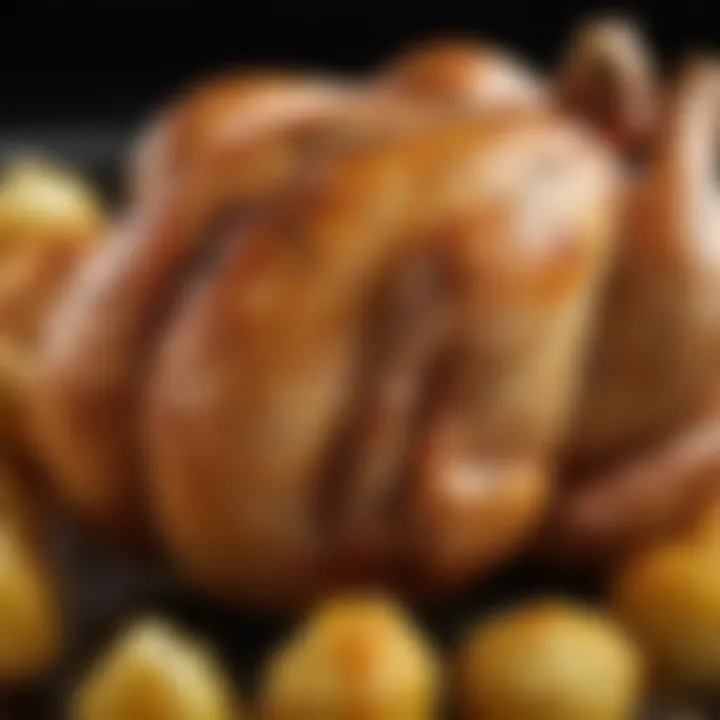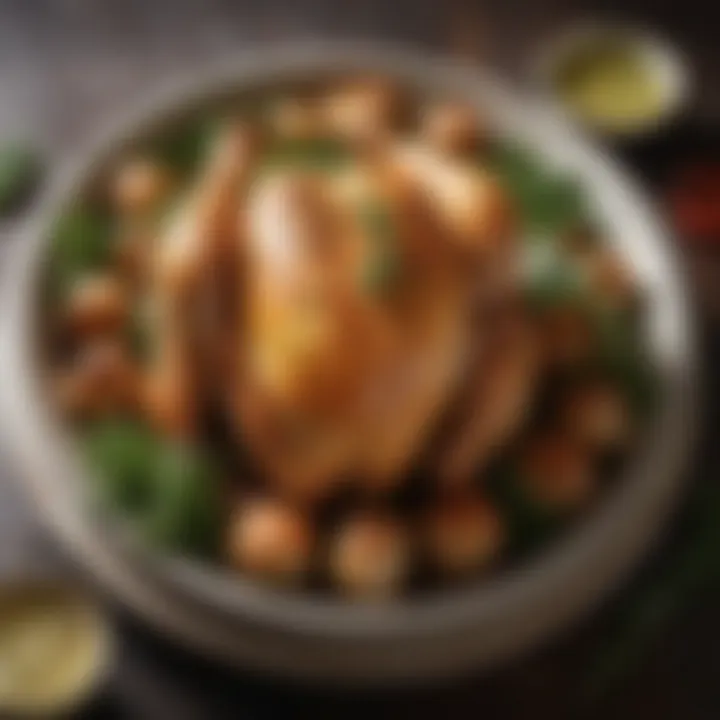The Ultimate Baked Chicken Rub Guide for Flavor Boost


Intro
Baked chicken is a popular and versatile dish enjoyed by many. The key to unlocking its potential lies in the use of a well-crafted rub. A baked chicken rub is a blend of spices and herbs that can transform a simple meal into a flavorful experience. By applying these rubs correctly, home cooks can enhance the chicken's natural juices and create layers of taste that delight the palate.
In this guide, we will explore the fundamentals of baked chicken rubs, dissecting ingredients and techniques to ensure optimal flavor. As we proceed, we aim to provide practical advice tailored for busy individuals and culinary novices alike. This guide serves not only as an educational resource but also as an invitation to experiment with flavors in your own kitchen. With the right knowledge, preparing an exceptional baked chicken dish is within everyone’s reach.
Recipe Highlight
Let’s kick off with an enticing recipe: Herb and Garlic Baked Chicken. This dish is crisp on the outside and tender within, delivering a mouthwatering taste that satisfies.
Essential Ingredients:
- 4 chicken breasts
- 2 tablespoons olive oil
- 1 tablespoon dried oregano
- 1 tablespoon garlic powder
- 1 teaspoon paprika
- Salt and pepper to taste
Estimated Preparation Time: 10 minutes
Cooking Time: 30 minutes
Total Time: 40 minutes
Servings: 4
Step-by-Step Instructions
- Preheat your oven to 400°F (200°C).
- In a small bowl, combine the dried oregano, garlic powder, paprika, salt, and pepper.
- Drizzle olive oil over the chicken breasts and rub it in to coat them evenly.
- Sprinkle the spice mixture generously over the chicken, ensuring all sides are coated.
- Place the rubbed chicken breasts on a baking sheet lined with parchment paper.
- Bake in the preheated oven for about 25-30 minutes or until the chicken is cooked through.
- Let it rest for 5 minutes before serving.
Cooking Techniques
Ensure the oven is properly preheated before placing the chicken in to avoid uneven cooking. Using a meat thermometer can guarantee that the internal temperature reaches 165°F (74°C), ensuring safety and tenderness.
Variations and Substitutions
To cater to different tastes or dietary restrictions, consider substituting their ingredients:
- Chicken thighs can replace breasts for a richer flavor.
- Fresh herbs like thyme or rosemary can enhance the herb component.
- For a kick, add cayenne pepper or chili powder to the spice blend.
Consider serving the baked chicken with sides like roasted vegetables or a fresh salad for a complete meal.
Time-Saving Cooking Tips
Efficient preparation leads to better results:
- Chop herbs and mix spices in advance to save time.
- Using a food processor can expedite the mixing of spices.
- Batch-cooking chicken and storing it can make meal planning easier for the week ahead.
Nutritional Information
A serving of herb and garlic baked chicken approximately contains:
- Calories: 280
- Protein: 28 g
- Fat: 14 g
- Carbohydrates: 0 g
This dish is high in protein, making it suitable for those looking to increase their protein intake. It is also gluten-free and can fit into various diet plans.
Overall, the baked chicken rub offers a simple yet impactful way to enhance the flavor of chicken. With some thoughtful preparation and the right rub, anyone can create a dish that impresses.
Understanding Baked Chicken Rub
Baked chicken rub serves as an essential component for those seeking to amplify the flavor profile of their dishes. Discussing this topic provides insights into various rubs that can transform the mundane into the remarkable. Understanding baked chicken rub is crucial for improving both taste and dining experience, making it a valuable addition to any kitchen. This section lays the foundation for further exploration into its elements and their respective roles.
Definition and Purpose
A baked chicken rub is a mixture of spices and herbs that enhances the flavor of chicken before cooking. It can be applied directly onto the skin or meat of the chicken, allowing flavors to penetrate during the cooking process. The purpose of using a rub is simple: to enhance the overall flavor without overwhelming the natural taste of the chicken. The right combination of ingredients can bring depth and complexity that elevates the dish to new heights.
This approach not only contributes to flavor but can also enhance texture. When applied correctly, the rub forms a crust as the chicken cooks. This crust can contribute to a more enjoyable eating experience by providing a satisfying contrast to the tender meat within. The overall effectiveness of a baked chicken rub rests on its ingredients and their proportions, making it vital to strike a balance in each blend.
Culinary Significance
The culinary significance of baked chicken rub cannot be understated. In the world of gastronomy, seasoning is fundamental. A well-crafted rub can distinguish a dish from others that are more bland. It allows chefs and home cooks alike to express creativity and showcase personal taste preferences. Moreover, using rubs provides an opportunity to infuse international flavors into everyday meals.
Additionally, baked chicken rubs are highly adaptable. Depending on the chosen spices and herbs, one can easily cater to dietary restrictions or preferences. For instance, a person might want a low-sodium option, which can be achieved by minimizing salt in the rub while substituting with other flavor agents. This flexibility ensures that baked chicken rub remains relevant and significant in diverse culinary settings.
Moreover, utilizing a rub often simplifies the cooking process, as it reduces the need for marination time while still incorporating layers of flavor. For busy individuals seeking quick yet flavorful meals, baked chicken rub represents a practical solution to elevate their dish outcomes with minimal time investment.
Core Ingredients of Baked Chicken Rub


The core ingredients of baked chicken rub are essential for delivering flavor and depth to your chicken dishes. Understanding these ingredients helps cooks to create their own unique blends. Instead of relying on store-bought rubs, one can combine flavors to match personal taste preferences. The key lies in knowing how each ingredient contributes to the overall profile of the rub. Choosing quality ingredients also makes a significant difference in taste.
Spice Blends
Spice blends form the foundation of any effective baked chicken rub. They add warmth and character. Common spices include paprika, cumin, garlic powder, and onion powder. Each spice serves a particular role:
- Paprika brings a mild sweetness and vibrant color.
- Cumin imparts an earthy flavor, elevating the overall taste.
- Garlic powder and onion powder enhance savory notes, making the chicken more appetizing.
These spices can be adjusted based on flavor preferences. For instance, increasing the amount of chili powder gives a kick, while more paprika can soften the heat. A well-balanced spice blend is crucial in ensuring that no single flavor dominates too much.
Herbs and Seasonings
Herbs and seasonings are equally important in complementing the spices. Common choices include rosemary, thyme, and oregano. These herbs bring freshness to the dish. Incorporating dried or fresh herbs can amplify the flavor significantly. While dried herbs blend easily into rubs, fresh herbs add a more vibrant flavor punch. When working with herbs, keep the following in mind:
- Dried herbs maintain their flavors but tend to be more subtle.
- Fresh herbs provide brightness, making them a perfect choice for marinades or last-minute additions just before cooking.
It’s important to consider the cuisine you are aiming for. For instance, Italian-inspired blends may use basil and oregano, whereas a classic Southern-style rub might benefit from thyme.
Non-Traditional Additions
Adding non-traditional ingredients can push the boundaries and enhance the flavor profile of baked chicken rub significantly. Common non-traditional elements include:
- Citrus Zest: Grated lemon or lime zest adds brightness.
- Brown Sugar: A touch of sweetness can create caramelization during cooking.
- Coffee or Cocoa Powder: These ingredients add depth and complexity, creating unexpected notes.
When experimenting with these non-traditional additions, use them sparingly. They should enhance the flavor rather than overwhelm it. Finding the right balance is essential for creating a distinctive rub that remains complementary to the chicken.
"Using quality core ingredients not only enhances flavor but also brings creativity to cooking."
Creating Your Own Baked Chicken Rub
Creating your own baked chicken rub offers numerous advantages. The ability to control flavor and customize according to personal preferences adds a unique aspect to the culinary experience. Additionally, homemade rubs often utilize fresher ingredients, enhancing the overall taste of the chicken. As the staple of many kitchens, these rubs serve as a gateway to exploring diverse flavors, shades, and preferences.
Combining Flavors
In the world of culinary arts, combining flavors is essential for developing a unique baked chicken rub. One must consider how spices and herbs interact. For instance, garlic powder and paprika pair well together, adding depth and complexity. Meanwhile, blending cumin with coriander can introduce a warm, earthy note that elevates the dish.
To create a successful rub, it is helpful to begin with a base of popular spices such as salt, pepper, and a primary flavoring such as paprika or chili powder. After establishing a solid foundation, experiment with the addition of herbal elements like thyme or oregano. These products not only enrich the overall taste but also contribute to a well-rounded flavor profile.
Balancing Heat and Sweet
When crafting your baked chicken rub, achieving a balance between heat and sweet is crucial. Heat can come from various sources: cayenne pepper, chili powder, or even black pepper. Pairing these with sweet components, such as brown sugar or honey, can transform flavors remarkably. The sweetness not only mitigates the heat but also creates a caramelly crust on the chicken when added during the cooking process.
For instance, using equal parts brown sugar and cayenne can lead to a pleasing contrast that many find irresistible. Alternatively, if you enjoy more heat, consider raising the cayenne and lowering the sugar to suit your taste. The goal is to entice the palate, ensuring each bite arrives with complexity and enjoyment.
Experimenting with Ratios
Experimentation with ratios is paramount in creating the perfect baked chicken rub. Different meats and cooking methods can influence the ideal mix. For instance, a rub designed for chicken thighs may differ from one for chicken breasts, given the varying fat content and moisture levels.
Start with common ratios, such as a one-to-one measurement of salt to sugar and build from here. Gradually adjust seasoning until you find the balance that works for you. Documenting the amounts used in each attempt can be helpful. Note what you like, and how it can improve.
This practice not only enhances your culinary skills but also allows for gradual improvement in flavor profiles. Ultimately, through trial and error, you can create a rub that genuinely speaks to your taste preferences.
Practical Application of Baked Chicken Rub
Applying a baked chicken rub is essential to achieving enhanced flavor in your dishes. Understanding the practical methods allows cooks to maximize the rub's effectiveness, resulting in more enjoyable meals. The timing of application and the recommended techniques play crucial roles in how well the rub penetrates the chicken, shaping the overall taste and texture.
Timing of Application
Timing is important when applying baked chicken rub. Depending on the method chosen, it can influence how flavors meld with the chicken.
Pre-Marination Methods
Pre-marination methods involve applying the rub before cooking, allowing flavors to infuse into the meat during the marination period. This is beneficial because it tenderizes the chicken while enhancing its flavor. One key characteristic of pre-marination is the ability to incorporate various spices alongside the rub, which can deepen the flavor profile.
Advantages of this method include:
- Improved flavor penetration.
- Increased moisture retention in the chicken.
- Simplicity in preparation, as it allows for the chicken to be marinated ahead of time.
However, the downside is that marinating requires time which might not always fit into a busy schedule. In general, marinating for at least 30 minutes is recommended, though longer marination can provide even better results.


Mid-Cooking Techniques
Mid-cooking techniques involve adding or reapplying the rub while cooking is in progress. This method is particularly useful when roasting or grilling, as it can help to develop a crust on the chicken. The key characteristic of mid-cooking application is that it allows for fresh flavor boosts at crucial moments during the cooking process.
Advantages of mid-cooking methods include:
- Flexibility in managing cooking times.
- Enhanced flavor contrast between the initial rub application and the later addition.
- Prevention of the rub from burning if applied too early, which can happen in some cooking methods.
Yet, it is essential to monitor the chicken closely once the rub is reapplied mid-cooking. Timing must be perfect to ensure the rub adheres but does not burn into an overly harsh taste.
Recommended Techniques
Applying the rub effectively can significantly impact the overall result of the chicken dish. Each technique has its own merits that contribute to the desired taste.
Rubbing and Massaging the Chicken
Rubbing and massaging the chicken with the rub ensures even distribution and better absorption of flavors. This tactile method is popular, as it creates a direct interaction between the spices and the meat. The key characteristic of this technique is its ability to break down muscle fibers slightly, optimizing flavor penetration.
Pros of rubbing include:
- Immediate flavor integration, which enhances the chicken’s taste.
- The possibility of enhancing the texture by making it more tender and flavorful.
Nonetheless, it's crucial to avoid over-massaging, as it can cause the meat to become mushy. A gentle touch is usually sufficient to achieve the best results.
Basting During Cooking
Basting during cooking involves applying the rub or a liquid (such as broth) on the chicken at intervals while it cooks. This method helps maintain moisture in the meat, leading to tender, juicy results. Its unique feature lies in the balancing act of ensuring the flavor remains vibrant while preventing dryness.
Advantages of basting include:
- Enhanced juiciness in the finished product.
- Added layers of flavor, which can modify and elevate the base taste.
However, frequent opening of the oven or grill can lead to heat loss. Therefore, it’s essential to balance basting with maintaining steady cooking temperatures.
Rub Variations for Different Flavor Profiles
The diversity of flavor profiles in baked chicken rubs is crucial in enhancing dishes. Each variation brings a unique taste that can transform a simple meal into a culinary experience. Understanding these variations allows cooks to match different rubs with specific chicken preparations and personal preferences. This knowledge is not only beneficial for flavor enhancement, but it also expands the opportunity for creativity in the kitchen.
Traditional BBQ Rubs
BBQ rubs are characterized by their smoky, sweet, and spicy notes. These rubs typically combine ingredients like brown sugar, paprika, garlic powder, and cayenne pepper. The balance between sweet and spicy helps create a robust flavor that complements the natural taste of chicken.
Using traditional BBQ rubs enhances the caramelization during baking, contributing to a visually appealing crust. When applied before cooking, these rubs penetrate the meat, allowing the flavors to deepen. Many individuals find that using BBQ rubs is ideal for family gatherings, BBQs, or any informal dining experience.
Herb-Infused Rubs
Herb-infused rubs offer a fresh take on flavoring baked chicken. Mixing dried or fresh herbs such as rosemary, thyme, and oregano with spices can produce a fragrant and vibrant seasoning. These rubs are perfect for those who prefer a lighter taste profile while still enjoying the depth provided by herbs.
Unlike BBQ rubs, herb-infused options might focus more on the savory and aromatic aspects rather than sweetness. They are particularly loyal to Mediterranean cooking styles, giving a nice twist to the overall experience. This type of rub is often used for weeknight dinners when a refreshing, light dish is desired without much preparation time.
International Flavor Inspirations
Expanding the palate, international flavor inspirations in chicken rubs introduce bold spices from around the world. For example, a Moroccan-inspired rub might use cumin, coriander, and cinnamon, while a Caribbean version could incorporate allspice and jerk seasoning.
Each of these variations reflects cultural traditions and regional tastes. The benefit of using international flavors is the ability to diversify meals significantly. By experimenting with these different influences, cooks can explore new flavors without needing extensive knowledge of the culinary traditions behind them.
"Flavors are the heart of cooking, and exploring international influences can widen the scope of every dish."
These rub variations not only enhance flavor but also encourage culinary exploration. The result is not just a feast of tastes but also an adventure into different cultures, making mealtime more exciting.
Storage and Shelf Life of Baked Chicken Rub
Proper storage and understanding the shelf life of baked chicken rub are crucial for maintaining its flavor and effectiveness. Many cooks may prepare a batch of rub and expect it to last indefinitely, but the reality is that spices and herbs can lose potency over time. By knowing how to store your rub properly, you can prolong its freshness and flavor, ensuring each dish benefits from optimal seasoning.
Proper Storage Techniques
Storing baked chicken rub correctly involves a few fundamental techniques that anyone can follow:


- Use Airtight Containers: The first step is to use airtight jars or containers. Glass or plastic containers with tight-fitting lids help to keep moisture and air out, preventing the rub from clumping and maintaining its aroma.
- Cool, Dark Location: Store the rub in a cool, dark place, away from direct sunlight and heat. High temperatures and light can degrade the quality of spices, affecting flavor and potency.
- Label and Date: It is advisable to label the container with the contents and the date it was made. This practice helps you to keep track of its freshness and reminds you to use it within a reasonable timeframe.
- Avoid Humidity: Keep the rub away from humid areas, such as near the stove or sink. Moisture can cause spices to spoil more quickly.
Using these guidelines ensures that your baked chicken rub remains flavorful and ready for use whenever needed.
Signs of Spoilage
Over time, even the best-stored spices can lose their qualities. Here are some signs that your baked chicken rub may have gone bad:
Smell Test: If the aroma of the rub has significantly weakened, it's a strong sign that the spices have lost their freshness. Fresh herbs and spices should have a strong, inviting scent.
- Visual Check: Look out for color changes or clumping. If the rub appears to have lost color or if it has hardened into clumps, it may be time to discard it.
- Taste Test: Although not ideal, you can perform a small taste test. If the flavor is muted or off, it is a clear indication that the rub should be thrown away.
Using these indicators allows you to ensure only the best-quality rub is used in your cooking, preserving the integrity of your dishes.
Enhancing Cooking Techniques with Baked Chicken Rub
Cooking chicken can sometimes feel like a simple task. However, enhancing it with a baked chicken rub can take it to another level. The use of rubs not only amplifies the flavor of the meat but also improves the cooking techniques used. Here, we will discuss how these enhancements can change the cooking experience and results.
Oven Baking Best Practices
When using a baked chicken rub in the oven, there are some best practices that can optimize flavor and texture. Firstly, it is essential to preheat the oven. A preheated oven allows the chicken to cook evenly. It helps in achieving that crispy skin while keeping the meat juicy inside.
- Choose the Right Temperature: Cooking at 375°F to 425°F often gives the best results for baked chicken. Higher temperatures can create a crispy exterior while ensuring the interior is thoroughly cooked.
- Apply the Rub Generously: Applying an even layer of rub across the chicken ensures that it penetrates the meat. Make sure to rub it under the skin if possible, as it can enhance flavor significantly.
- Use a Rack: Placing the chicken on a rack helps with even cooking. It allows air to circulate around the meat, promoting a better crust.
- Monitor Internal Temperature: Use a meat thermometer to check doneness. Chicken is safely cooked at an internal temperature of 165°F. This prevents undercooking while ensuring the meat retains moisture.
The end result will be a beautifully baked chicken, rich in flavor and texture.
Grilling with Rubs
Grilling is another technique where baked chicken rubs shine. The high, direct heat of a grill can add a delightful smokiness, which complements the spices in the rub. Here are some key points to consider:
- Preheat the Grill: Just as with the oven, preheating the grill is crucial. This not only reduces cooking time but also enhances the sear on the chicken.
- Utilize Indirect Heat: When grilling, consider using indirect heat. This means placing the chicken away from the direct flame. Indirect heat promotes even cooking without burning the rub.
- Baste for Moisture: While cooking, you can baste the chicken with marinade or a light mixture of oil and vinegar. This maintains moisture and flavor as the chicken cooks.
- Resting Period: Allowing the chicken to rest after grilling is vital. This period lets juices redistribute within the meat, making every bite tender and juicy.
"Proper techniques in cooking chicken with rubs can greatly enhance its flavor and texture. Both oven baking and grilling offer unique advantages that maximize the effectiveness of your chosen rub."
The combination of the right cooking methods and the use of baked chicken rubs fundamentally transforms the experience of preparing and enjoying chicken. Whether you opt for baking or grilling, knowing how to effectively use these techniques will ensure a delicious outcome every time.
Nutritional Considerations of Baked Chicken Rub
Understanding the nutritional aspects of baked chicken rub is central to the overall discussion of flavor enhancement and health. While rubs are typically associated with taste, their components can influence the health qualities of a meal. Gold standard rubs do more than add flavor; they can elevate nutritional value, especially when made with quality ingredients. It is essential to recognize which elements contribute beneficial properties and how to utilize them effectively.
Assessing Ingredient Quality
The quality of ingredients in a baked chicken rub cannot be overstated. This directly affects both the flavor and nutritional profile of the final dish. Fresh spices and herbs often possess higher levels of flavor compounds and essential nutrients compared to older, pre-packaged alternatives. When selecting spices, look for ones that are vibrant in color and aromatic. This indicates freshness.
When it comes to salt or sugar in your rub, moderation is vital. Opt for natural alternatives like garlic powder or onion powder. These can enhance flavor without adding unnecessary sodium or sugar, making for a healthier rub. Consider also the source of your herbs—organically grown versions may provide better flavors without pesticide residues. Integrating high-quality oils, such as olive oil, can also be beneficial since it provides healthy fats. It is a small step, but assessing ingredient quality pays off in flavor and health.
Tackling Health Concerns
The health implications of using a baked chicken rub are real and worth analyzing. Many individuals are increasingly concerned about dietary sodium, sugar, and preservatives found in processed rubs. To address these issues, focus on creating homemade blends. This allows you to control the amount of salt and sugar while avoiding unwanted additives.
Moreover, some herbs and spices have additional health benefits. For example, turmeric and paprika have anti-inflammatory properties, which could be beneficial in a balanced diet. Incorporating these into your rub could enhance not only the flavor but also the antioxidant content of your meal.
Be cautious of individuals with specific dietary restrictions or allergies. Always check ingredient labels if using packaged options, as cross-contamination can occur.
Summary and Final Thoughts
The exploration of baked chicken rubs provides more than just flavorful enhancements to chicken dishes; it reveals a deeper understanding of culinary art that can greatly elevate home cooking. Understanding the elements of a baked chicken rub—ingredients, application methods, and flavor profiles—sheds light on how seemingly simple spices can transform a basic meal into a culinary delight.
This guide serves as an essential resource for food lovers, home cooks, and anyone who wishes to enhance their chicken dishes without extensive culinary skills. Baked chicken rubs are versatile; they can accommodate myriad preferences, from spicy to savory, thus appealing to a broad audience. Furthermore, with knowledge about storage and shelf life, cooks can ensure their ingredients remain fresh, optimizing flavor and nutrition.
When we engage with the subject of baked chicken rubs, we encourage creativity in the kitchen. The process of making and applying rubs invites exploration of flavors, empowering individuals to customize their cooking experiences based on their tastes and dietary needs. By understanding the nuances of each spice and herb, cooks can uncover new and exciting combinations that suit their unique palates.
Key Takeaways
- Customization: The ability to create custom rubs allows for a personal touch in cooking, making every meal unique.
- Healthier Cooking: Homemade rubs often reduce reliance on store-bought mixes that may contain preservatives and excess sodium.
- Flavor Variations: Each rub offers a distinct departure in flavor, supporting an array of taste preferences—from spicy to herbaceous.
- Learning Opportunity: The process of experimenting with different ingredients is a way to learn more about culinary techniques and flavor balancing.
Encouraging Culinary Exploration
Encouragement to explore and experiment with baked chicken rubs is imperative for any aspiring cook. Cooking is inherently a creative endeavor, and using rubs is an excellent way to liberate one's culinary imagination. Start with basic combinations and gradually introduce new spices or herbs to develop a personal favorite.
Consider hosting a taste-test event with friends or family, where each person crafts their own rub. Discuss the flavor profiles encountered and share techniques. Engaging in such activities not only builds culinary skills but also fosters a sense of community.
Among the resources available, online platforms like Reddit can serve as a forum for sharing recipes, tips, and experiences related to baked chicken rubs. It's an opportunity to gather inspiration and insights that can enhance cooking practices.
Ultimately, the journey of flavor exploration through baked chicken rubs is not just about the final dish but also about enjoying the process of cooking itself. It invites cooks to take risks, learn from failures, and celebrate successes in the kitchen.







